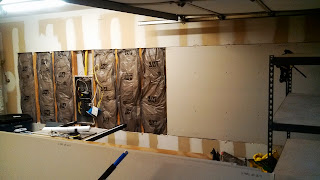 Well we are back from a blogging sabbatical, and this article is the first in a series on my man cave renovations. The project was to turn a standard builder's garage into the best man cave I could build with my own two hands [on a budget]. Step one was to turn down the heat a notch by adding insulation.
Well we are back from a blogging sabbatical, and this article is the first in a series on my man cave renovations. The project was to turn a standard builder's garage into the best man cave I could build with my own two hands [on a budget]. Step one was to turn down the heat a notch by adding insulation.
For reference, my garage is a standard two car garage measuring 17'x18' with only one wall adjacent to the house.
Step One: The Garage Door
The garage door was just a piece of shaped sheetmetal when I moved in so the first step was insulating that. I bought a Johns Manville R-8 Insulation Kit from Lowe's for about $120 (two required for a 2 car door) that bumped it up to an R8 insulation value. It came with styrofoam panels with white vinyl backing. The panels are then cut into the right length and then they pop into the horizontal slats. I did the whole project myself in less than 90 minutes. I actually installed this part in the winter and it added about 15 degrees to the outside temperature in the garage (so from about 40 degrees outside to 55 inside).
Step Two: The Attic
Going in the order of low hanging fruit, the next on the list was the attic. The roof above the garage soaks up heat, so in order to keep that heat from moving down into the garage I chose to go with a blown in cellulose insulation.
This option was both cheap and easy. I bought 20 bags for about $7.50 per bag and the store (Lowes and Home Depot will both do it) kicked in a 24 hour blower rental for free (well with a $100 deposit that you get back when you return the unit).
Check your local recommendations but in my area of Texas, R30 insulation was the minimum recommended. With 20 bags and approximately 300 square feet of attic to insulate I ended up with about an R60.
Installation was easy. I had a friend come over and he stayed in the garage and fed bags of insulation into the hopper while I was up with a hose blowing it in. As far as protective equipment, I wore goggles (courtesy of my Army kit), respirator, head lamp, ear protection, hat and gloves. The end result was more like Darth Vader than Bob the Builder. The insulation I bought wasn't fiberglass based so I could get away with wearing shorts and a t-shirt and still didn't get itchy. It gets dusty (about five feet visibility at times) but as long as you don't mind sweating a little and tight spaces it's not terrible- just don't expect a hug from the missus when you're done.
Total time from setup to clean up was 90 minutes. Couldn't be much easier.
Step Three: The Walls
Now for this part there were two options, rip down the sheetrock and install fiberglass batts (or spray in insulation if you have the money) or cut holes in between each of the cavities and fill it with blown in cellulose that will settle over time.
The start from scratch idea didn't really appeal to me as I was doing this all by myself and the cutting and patching of the cellulose option didn't sound like much fun either. So I opted for a hybrid approach.
I ended up cutting a 4-foot wide rip in the existing drywall along the exterior walls (I left the interior wall alone). Then, quite simply I cut batts to the proper length and shoved them in the crevices. No staples or other fasteners were required since the drywall on top and bottom held everything in place.
Demo took the longest. Installing the matts even with the cutting took me about an hour to finish the garage all by myself. It would have been faster had I just purchased the 8' long batts versus the 32' roll but I was looking to save a couple bucks so I went with the roll. Standard fiberglass R value in a 2x4 wall is R13 so that's what I was able to add.
Step Five: Back to Square One
At this point, everything that I wanted insulated was, so it was time to patch it all back up. I went ahead and filled in the portion over my bench with 1/2" plywood to keep that surface durable from the inevitable bumps and bruises a workbench area sees.
Other than that, it was a standard drywall job. Unfortunately, I couldn't find tools to bum off of anyone, so I bought a whole bunch of crap I didn't really want to do the tape and bedding. That's a whole new how-to article, so I'll refer you back to my references at One Project Closer.
Before mud
After mud
Before mud
After mud
(Sorry if that wasn't the most exciting set of before and after's you've ever seen.)
So at that point the garage more or less looked like it did when it started. Here's the kicker though- most people expected that adding all this insulation must make the garage cool in the summer. Unfortunately not. Insulation doesn't make anything cool, it slows the transfer of heat. (I'll stop now before this turns into a lecture on thermodynamics...) My garage now needed a way to take the heat inside the garage and pump it out. Stay tuned.
![[callsign]KTF](http://4.bp.blogspot.com/-gnVang4D1o8/T0RMlS8Ay5I/AAAAAAAAAB4/cCGCzOyU_6g/s1600/KTF%2BBanner-Mountain.jpg)











No comments:
Post a Comment